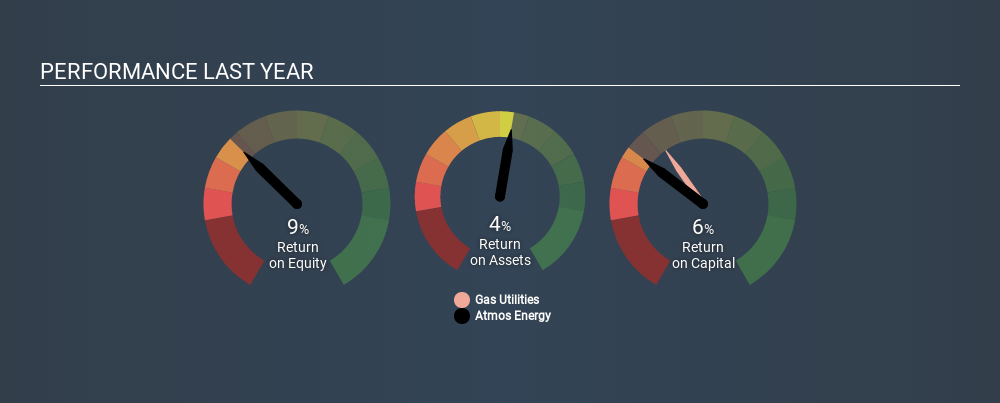Stock Analysis
- United States
- /
- Gas Utilities
- /
- NYSE:ATO
Is Atmos Energy Corporation’s (NYSE:ATO) Return On Capital Employed Any Good?

Today we'll look at Atmos Energy Corporation (NYSE:ATO) and reflect on its potential as an investment. Specifically, we'll consider its Return On Capital Employed (ROCE), since that will give us an insight into how efficiently the business can generate profits from the capital it requires.
First of all, we'll work out how to calculate ROCE. Second, we'll look at its ROCE compared to similar companies. Last but not least, we'll look at what impact its current liabilities have on its ROCE.
What is Return On Capital Employed (ROCE)?
ROCE measures the 'return' (pre-tax profit) a company generates from capital employed in its business. All else being equal, a better business will have a higher ROCE. Overall, it is a valuable metric that has its flaws. Author Edwin Whiting says to be careful when comparing the ROCE of different businesses, since 'No two businesses are exactly alike.
How Do You Calculate Return On Capital Employed?
The formula for calculating the return on capital employed is:
Return on Capital Employed = Earnings Before Interest and Tax (EBIT) ÷ (Total Assets - Current Liabilities)
Or for Atmos Energy:
0.057 = US$768m ÷ (US$14b - US$845m) (Based on the trailing twelve months to December 2019.)
Therefore, Atmos Energy has an ROCE of 5.7%.
Check out our latest analysis for Atmos Energy
Does Atmos Energy Have A Good ROCE?
ROCE is commonly used for comparing the performance of similar businesses. We can see Atmos Energy's ROCE is around the 5.5% average reported by the Gas Utilities industry. Aside from the industry comparison, Atmos Energy's ROCE is mediocre in absolute terms, considering the risk of investing in stocks versus the safety of a bank account. It is possible that there are more rewarding investments out there.
Atmos Energy's current ROCE of 5.7% is lower than its ROCE in the past, which was 7.8%, 3 years ago. Therefore we wonder if the company is facing new headwinds. You can click on the image below to see (in greater detail) how Atmos Energy's past growth compares to other companies.

It is important to remember that ROCE shows past performance, and is not necessarily predictive. ROCE can be misleading for companies in cyclical industries, with returns looking impressive during the boom times, but very weak during the busts. ROCE is only a point-in-time measure. Future performance is what matters, and you can see analyst predictions in our free report on analyst forecasts for the company.
What Are Current Liabilities, And How Do They Affect Atmos Energy's ROCE?
Liabilities, such as supplier bills and bank overdrafts, are referred to as current liabilities if they need to be paid within 12 months. Due to the way ROCE is calculated, a high level of current liabilities makes a company look as though it has less capital employed, and thus can (sometimes unfairly) boost the ROCE. To check the impact of this, we calculate if a company has high current liabilities relative to its total assets.
Atmos Energy has current liabilities of US$845m and total assets of US$14b. Therefore its current liabilities are equivalent to approximately 5.9% of its total assets. Atmos Energy reports few current liabilities, which have a negligible impact on its unremarkable ROCE.
Our Take On Atmos Energy's ROCE
If performance improves, then Atmos Energy may be an OK investment, especially at the right valuation. Of course, you might also be able to find a better stock than Atmos Energy. So you may wish to see this free collection of other companies that have grown earnings strongly.
If you are like me, then you will not want to miss this free list of growing companies that insiders are buying.
If you spot an error that warrants correction, please contact the editor at editorial-team@simplywallst.com. This article by Simply Wall St is general in nature. It does not constitute a recommendation to buy or sell any stock, and does not take account of your objectives, or your financial situation. Simply Wall St has no position in the stocks mentioned.
We aim to bring you long-term focused research analysis driven by fundamental data. Note that our analysis may not factor in the latest price-sensitive company announcements or qualitative material. Thank you for reading.
About NYSE:ATO
Atmos Energy
Engages in the regulated natural gas distribution, and pipeline and storage businesses in the United States.
Solid track record with adequate balance sheet and pays a dividend.

